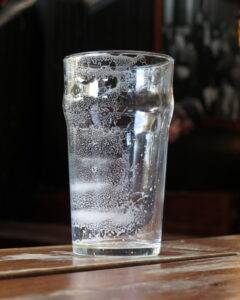
The 2024 New Zealand Beer Awards — formerly (and affectionately) known as the BGONZAs — were announced over the weekend, which means it’s time again to dive into the results and seek out whatever curious details lurk under the surface. This year saw a few breweries return to form, some interesting rearrangement among trophy classes, and maybe an uncommon (and underexplained) tie-break at the top.
As always, because the Brewers Guild provide a list of every beer that entered, a little basic work with a spreadsheet can give us a few different angles on the results. I’ve worked out each entrant’s medal percentage (MPC: what proportion of their beers one a medal of any kind) and points per entry (PPE: 3 for gold, 2 for silver, 1 for bronze, divided by number of submissions). Overall, 76.5% of beers were awarded a medal, and 1.00 was the median PPE. The table below lays out the data for breweries entering ten or more beers.1
Performance at the 2024 BGONZAs, by breweries entering ten or more beers
n = number of entries, MPC = medal percentage, PPE = points per entry, G/S/B = individual medals, 🏆 = brewery Championship titles, 🍺 = brewer of the Champion NZ beer
| Brewery | n | MPC | PPE | G | S | B |
|---|---|---|---|---|---|---|
| Three Boys (🏆 'Overall' Champion) | 12 | 100 | 2.17 | 5 | 4 | 3 |
| Parrotdog (🏆 Large Brewery) | 20 | 100 | 2.05 | 4 | 13 | 3 |
| Shining Peak (🏆 Small Brewery) | 15 | 100 | 2.00 | 4 | 7 | 4 |
| McLeod's (🍺 and 🏆 Medium Brewery) | 21 | 85.7 | 1.90 | 8 | 6 | 4 |
| Bach | 10 | 100 | 1.90 | 3 | 3 | 4 |
| Garage Project | 22 | 90.9 | 1.82 | 6 | 8 | 6 |
| Panhead | 14 | 100 | 1.79 | 3 | 5 | 6 |
| Sprig + Fern | 20 | 100 | 1.70 | 5 | 4 | 11 |
| Behemoth | 26 | 92.3 | 1.65 | 5 | 9 | 10 |
| Mount | 19 | 89.5 | 1.63 | 2 | 10 | 5 |
| Good George | 12 | 100 | 1.58 | 1 | 5 | 6 |
| Emerson's | 23 | 91.3 | 1.52 | 3 | 8 | 10 |
| Lion (incl. Mac's, Speight's) | 23 | 78.2 | 1.48 | 4 | 8 | 6 |
| Brave | 13 | 84.6 | 1.46 | 1 | 6 | 4 |
| Beer Baroness | 15 | 80 | 1.40 | 2 | 5 | 5 |
| Fork & Brewer (🏆 Micro Brewery) | 13 | 84.6 | 1.31 | 2 | 2 | 7 |
| D.B. (incl. Monteith's, Tuatara) | 13 | 92.3 | 1.31 | 0 | 5 | 7 |
| Heyday | 13 | 84.6 | 1.31 | 0 | 6 | 5 |
| Altitude | 25 | 88 | 1.28 | 2 | 6 | 14 |
| Sunshine | 10 | 80 | 1.20 | 1 | 2 | 5 |
| Lakeman | 19 | 78.9 | 1.16 | 2 | 3 | 10 |
| Wigram | 13 | 84.6 | 1.15 | 0 | 4 | 7 |
| Three Sisters | 13 | 69.2 | 0.92 | 1 | 1 | 7 |
| Hop Federation | 13 | 61.5 | 0.85 | 1 | 1 | 6 |
| Eddyline | 21 | 71.4 | 0.81 | 1 | 0 | 14 |
| Beers by Bacon Brothers | 20 | 45 | 0.55 | 0 | 2 | 7 |
| Two Thumb | 12 | 33.3 | 0.42 | 0 | 1 | 3 |
McLeod’s ‘Tropical Cyclone’ DIPA won the ‘Best In Show’ title, which earns it the header image here,2 but their beers aren’t available over here in Melbourne, and so my mind just kept circling back to the last time I was actually in the tropics. Other than noting that an IPA hadn’t taken the overall Champion NZ Beer crown since its inauguration in 2018, there’s not much analysis that can be done on that award,3 though it does fit the overall theme of return the other headline Championship winners all share. Every brewery that won had done so before, but with a different number of intervening years away from the podium. As group, the 2024 winners are much more tightly bunched on my table; there’s none of the wild variance we’ve previously seen in MPC / PPE performance, and even the relative quantities of beers they all entered are conspicuously closer.4 Ordinarily, these posts are largely about the different roads to victory taken by each Champion, and what it implies about their strategies. Not so, this time, though there’s still plenty of interesting details.
Starting with the “Overall Champion” title,5 since it’s awarded on a different basis — essentially PPE, with a few caveats6 — Three Boys retook the trophy from 8 Wired, and while they did so with a fractionally lower score, it also came with an impressive haul of medals that would’ve put them in regular-Championship contention (in the ‘medium’ tier, presumably) in many other years. Isthmus Brewing had an even better PPE of 2.33, but were one beer short of eligibility for this category; if they’d entered another which scored a silver or gold, it would’ve gone to them.

Shining Peak were the sole Champion to directly defend a title from last year, again winning the small-brewery tier, improving their medal percentage to a perfect 100 while maintaining their PPE. (Despite doing well at the recent Australian competition, previous repeat winners of this category Three Sisters were way off the pace, here — which I only point out because it makes this deeply weird ‘advertorial’ they just ran, in the week after the local awards, read like stolen valor.) Meanwhile Fork, formerly back-to-back Champions in this category (2018 and 2019) themselves, this year contested one tier down as a ‘micro’ brewery and were victorious there. My understanding is that their facility hovers around the cut-off point set between the two tiers, and so a slight downturn in production took them from the low end of small into the high end of micro. While their MPC and PPE are the lowest of this year’s title-holders, it’s by a much narrower margin than I’ve often seen; even accounting for the general trend upwards (about which more later), their stats are well ahead of many previous winners of whatever size.
McLeod’s had two years away from the winner’s podium but reclaimed the medium-sized brewery Championship in decisive fashion. Their MPC and PPE performance had steadily improved each year since they last won,7 but this year saw them also quadruple their previous gold medal tally, taking home more than any other entrant and enough to earn top honours if the production-based tiers didn’t exist. A quick look at last year’s table shows they essentially made that improvement by turning silvers into gold,8 rather than spamming more entries and playing the odds. Given how well McLeod’s did, they were well clear of their peers, but it’s worth pausing to acknowledge Sprig + Fern’s result (and my best bet is they’d belong in this tier, so I’m doing it now). After some frankly abysmal MPCs in early runs of this analysis, they caught up with the competition in 2023 and then had a perfect run this year with all 20 beers medaling and a top-end PPE.
Parrotdog9 had the longest time between Championships, and graduated up a size class since winning in 2018, the year the tiered system was introduced. Now ‘large’, they scored a perfect 100 MPC (also from 20 beers) and the third best PPE of the whole field, which is a stunning improvement after a notable dip in those numbers between titles. But you might’ve already noticed that deposed three-time-title-holder Garage Project10 had more gold medals, which is usually a reliable indicator of who will be named as ‘Champion’. The actual process is more detailed, but I’ve never had to spell it out before, as “most golds” always worked as a proxy. The rule is:11
The Trophy will be judged on the brewery’s top four scoring beers. In the event of a tie for a Champion New Zealand Brewery Trophy, the fifth ranked (and subsequent) beers will be considered. Consideration will be given to entries from the entrants that have been awarded trophies. Medals awarded to beers brewed under contract are not eligible for calculation towards this trophy.

So. One possible explanation is Parrotdog’s four gold medals collectively scored higher than the best four from Garage Project — if the rule is using the raw scores from the judges, not the medals they turn into. Out of 20 points, 14-15.4 gets a bronze, 15.5-16.9 earns a silver, and 17+ wins gold;12 so there’s plenty of room for these four golds to be “better” than those ones, and there goes the title. It’s unclear if this is the sense of “score” that first sentence is intending, but the reference to “medals” in the final one probably implies they do mean 3 points for gold, etc.. So maybe a few G.P. beers were produced at bStudio and therefore ineligible.13 I said last time that an entry’s contract-or-in-house status should be public, and here’s a whole other reason why. Or perhaps the unspecified “consideration” of trophy-winning beers kicks in whether or not there’s a tie, and Parrotdog had two of those this year while Garage Project had none (for the first time since 2018). If you ask me — and I did survive several years of law school — that’s some extremely ambiguous drafting. Maybe both factors were in play.14 It would be nice if this kind of thing was explained proactively by the Guild, but I haven’t seen mention of it anywhere.15
Meanwhile, as Michael Donaldson reported, there’s the curiosity that Parrotdog’s trophy in the International Lager category was awarded to a small-batch Cold IPA. He notes that it’s brewed with a lager yeast, and a quick look at the style guidelines confirms that “American-Style India Pale Lager” has been included in the category,16 and that’s arguably where such a beer belongs17 — though I’d just as happily say it’s a kind of IPA, whatever strain does the fermenting. Years ago, I wrote about the Guild’s (then-new) rule that a beer “will not be eligible to win a trophy if the commercial name of the entry stylistically differs from the class it was entered in”, but I hope this is too much of a line ball for anyone to get upset about, nowhere near the level of silliness Tui (2024 silver medalist, by the way) gets up to. And in any case, the rule no longer explicitly appears in the competition guidelines.
But speaking of trophy classes, they also saw a bit of a reshuffle. Putting NZ Draught in with locally-styled IPA and Pale, rather than our Lager and Pilsner varieties, seems strange to me. Splitting “Juicy/Hazy” into Pale Ale and IPA sections makes a lot more sense, but seeing the latter category — still the one riding high in the market — produce only one gold medalist from 44 entrants was grim. It’s a big drop from last year, so I’m curious as to the cause, though perhaps a more critical mood simply set in at that table. But spare a thought for the Wheat & Other Grain category, now down to just six entrants, and probably due for a refiling into oblivion; from popular gateway beer (and core range staple) to absolute afterthought.
Finally, the competition-wide medal percentage has been climbing the whole time I’ve been doing this, starting at 52% in 2017 and now standing at 76.5% — which the Guild’s director describes as “testament to the quality of New Zealand beer, to the skills of our brewers and to the industry as a whole”. And, sure. But I think it’s clear that getting better at entering competitions is at least as big a factor as being good at making beer.18 Breweries are vetting their own entries more carefully and trying to put their best foot forward.19 This is a good thing, and it shouldn’t be written off as a partial cause of the steady decline in total entries that we’ve also seen every year since the high water mark of 955 in 2019. As well as being pre-pandemic, that figure includes fifty ciders, which have since been (rightly, I think) removed. This year’s total of 695 also compares favourably to the submissions to beer awards over here in five-times-more-populous Australia; The Indies this year had just over 1,000 and the AIBAs around 1,700. On a per capita basis, there’s still room for optimism — and it’s Olympics season, when New Zealanders love a per capita basis.
And… that’s enough for now. As I said last time — I really didn’t mean to do two awards debriefs in a row — if you’ve made it this far and found my commentary useful and/or entertaining, then the chances are pretty good that you know someone else who will, too; forward it along or share it wherever you share these things. The internet being in the sad state it is, I appreciate the help in spreading the word.
- This cuts out the noisier end of the data and makes for better comparison among the Championship contenders; the full table is available here if you’re curious. And thanks once again and always to the brilliant TablePress plugin for making this so easy.
- By recent tradition, after 8 Wired’s ‘Wild Feijoa’ and Garage Project’s ‘Chance, Luck & Magic’.
- It’s presented to the winner of a final taste-off among the beers that earned trophies in the various style categories (India Pale Ale, International Lager, etc.), but the scoring isn’t made public.
- Last year, the gap between the most and the fewest entries by a ‘Champion’ was forty-seven beers, or a factor of ten (8 Wired’s 5 vs. Behemoth’s 52); this year there’s just nine beers between Three Boys’ 12 and McLeod’s 21.
- Scare-quotes because, as I said in my look at last year’s results, this is a terrible and confusing name for the award.
- 2024 NZBA Entry Guide, p8
- And indeed, both were better than the actual winner’s in the intervening years, but that’s not how the Guild decides on its Champions.
- In 2023, their medal balance was 2/11/4, this year its 8/6/4 — and with three fewer beers entered, leading to a marked uptick in MPC and a massive improvement in PPE.
- Who, it’s worth mentioning by way of a disclaimer, I’ve written a lot of label text for over the last nine years.
- Who, it’s equally worth mentioning by way of another disclaimer, I also worked for, years ago.
- 2024 NZBA Entry Guide, p10 (emphasis in original)
- 2024 NZBA Entry Guide, p 21
- See here for an ancient (and misleadingly-titled) article. ‘BEER’ is the best bet, here, but I’m not sure about their other gold-medal beers. Two (‘Chance, Luck & Magic 2020’ and ‘Single Barrel 205: Raspberry’) are definitely made ‘in-house’ at the Wild Workshop, but it’s possible they contract out ‘White Mischief’ or maybe ‘Spicy Pickle Beer’..?
- Purely for completeness, I have to note that there’s also the remote possibility — on the information we have — that G.P. have dropped down a production-size tier, like Fork did, to where they’d be running against McLeod’s superior medal haul. If that was the case, that would be frankly huge news, so I’m basically discounting it. It is frustrating that we don’t know how many breweries (nevermind which ones) are in each category.
- UPDATE, later the same day: Friday Night Beers has it that two GP golds were contract brewed and then the trophies broke a tie that would’ve eventually broken in Parrotdog’s favour anyway on the basis of silver medals.
- 2024 NZBA Entry Guide, p 33
- Hop Federation put theirs in the same place, three other breweries (Bach, Brave, Eddyline) filed theirs under ‘Experimental’, just going by the entries with “Cold IPA” in their name, at least.
- On the second episode of The Crafty Pint Podcast, my old Stomping Ground comrade Lindsay Astarita explains some of this really nicely (speaking both from the brewery and judging perspectives), starting from around the 30m mark.
- Which is one reason why you should pay extra attention to tastings that round up beers available in retail and taste those. I was a panelist on a few for Consumer or Capital Times back home, and always love to see The Crafty Pint’s ‘Getting Blind’ series.

Great work – thanks! Might the rankings (and perhaps winners) been different if there was a bonus point for winning a trophy?
Yeah, definitely. I’ve often toyed with the data to see what would happen under various scenarios like points for trophies or points off for non-medal beers. There’s obviously no one “right” way to do it and everything causes weird results at the edges.
This year’s results, I think, are actually a pretty good mark in the “everything’s probably fine” column, if you’re assessing the current system; no one spammed their way to victory, though I’m still pretty keen and curious to see proposals for avoiding that by design.
Happy Birthday